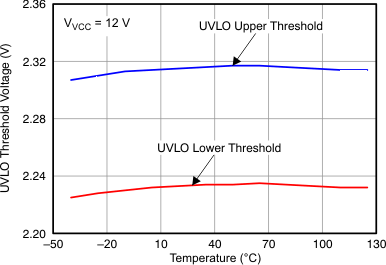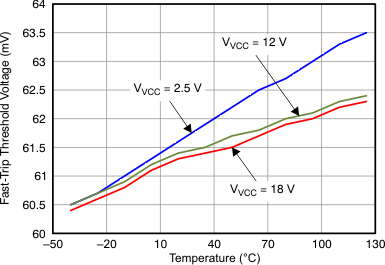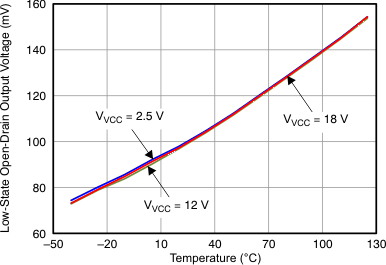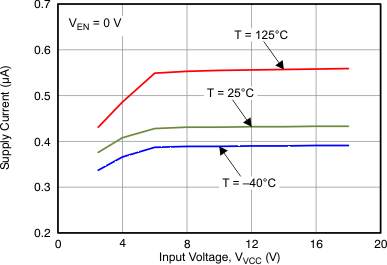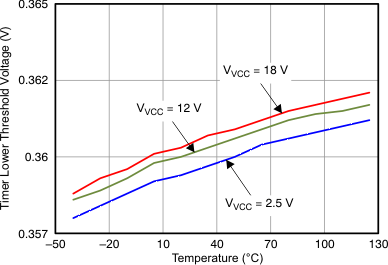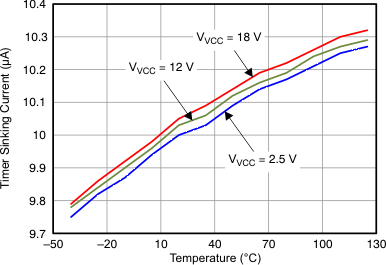SLVSAL1E March 2011 – April 2016 TPS24720
PRODUCTION DATA.
- 1 Features
- 2 Applications
- 3 Description
- 4 Revision History
- 5 Pin Configuration and Functions
- 6 Specifications
-
7 Detailed Description
- 7.1 Overview
- 7.2 Functional Block Diagram
- 7.3 Feature Description
- 7.4
Device Functional Modes
- 7.4.1 Board Plug-In
- 7.4.2 Inrush Operation
- 7.4.3 Action of the Constant-Power Engine
- 7.4.4 Circuit Breaker and Fast Trip
- 7.4.5 Automatic Restart
- 7.4.6 PGb, FLTb, and Timer Operations
- 7.4.7 Overtemperature Shutdown
- 7.4.8 Start-Up of Hot-Swap Circuit by VCC or EN
- 7.4.9 Minimization of Power Dissipation at STANDY by ENSD
- 7.4.10 Fault Detection of MOSFET Short With FFLTb
-
8 Application and Implementation
- 8.1 Application Information
- 8.2
Typical Application
- 8.2.1 Design Requirements
- 8.2.2
Detailed Design Procedure
- 8.2.2.1
Power-Limited Start-Up
- 8.2.2.1.1 STEP 1. Choose RSENSE, RSET, and RIMON
- 8.2.2.1.2 STEP 2. Choose MOSFET M1
- 8.2.2.1.3 STEP 3. Choose Power-Limit Value, PLIM, and RPROG
- 8.2.2.1.4 STEP 4. Choose Output Voltage Rising Time, tON, and Timing Capacitor CT
- 8.2.2.1.5 STEP 5. Calculate the Retry-Mode Duty Ratio
- 8.2.2.1.6 STEP 6. Select R1, R2, and R3 for UV and OV
- 8.2.2.1.7 STEP 7. Choose RGATE, R4, R5, R6, and C1
- 8.2.2.2 Additional Design Considerations
- 8.2.2.1
Power-Limited Start-Up
- 8.2.3 Application Curve
- 9 Power Supply Recommendations
- 10Layout
- 11Device and Documentation Support
- 12Mechanical, Packaging, and Orderable Information
パッケージ・オプション
メカニカル・データ(パッケージ|ピン)
- RGT|16
サーマルパッド・メカニカル・データ
- RGT|16
発注情報
6 Specifications
6.1 Absolute Maximum Ratings
over operating free-air temperature range, all voltages referred to GND (unless otherwise noted)| MIN | MAX | UNIT | |||
|---|---|---|---|---|---|
| Input voltage range | EN, FFLTb(1), FLTb(1), GATE, OUT, PGb(1), SENSE, SET(1), VCC | –0.3 | 30 | V | |
| ENSD, OV | –0.3 | 20 | |||
| PROG(1) | –0.3 | 3.6 | |||
| [SET, SENSE] to VCC | –0.3 | 0.3 | |||
| IMON, LATCH, TIMER | –0.3 | 5 | |||
| Sink current | FFLTb, FLTb, PGb | 5 | mA | ||
| Source current | PROG | Internally limited | |||
| IMON | 5 | mA | |||
| Temperature | Maximum junction, TJ | Internally limited | °C | ||
(1) Do not apply voltage directly to these pins.
6.2 ESD Ratings
| VALUE | UNIT | ||||
|---|---|---|---|---|---|
| V(ESD) | Electrostatic discharge | Human-body model (HBM), per ANSI/ESDA/JEDEC JS-001(1) | All pins except PGb | ±2000 | V |
| PIN PGb | ±500 | V | |||
| Charged-device model (CDM), per JEDEC specification JESD22-C101(2) | ±500 | V | |||
(1) JEDEC document JEP155 states that 500-V HBM allows safe manufacturing with a standard ESD control process.
(2) JEDEC document JEP157 states that 250-V CDM allows safe manufacturing with a standard ESD control process.
6.3 THERMAL INFORMATION
| THERMAL METRIC(1) | TPS24720 | UNIT | |
|---|---|---|---|
| QFN (16) PINS | |||
| RθJA | Junction-to-ambient thermal resistance | 47.3 | °C/W |
| RθJCtop | Junction-to-case (top) thermal resistance | 63.8 | °C/W |
| RθJB | Junction-to-board thermal resistance | 20.9 | °C/W |
| ψJT | Junction-to-top characterization parameter | 1.6 | °C/W |
| ψJB | Junction-to-board characterization parameter | 21 | °C/W |
| RθJCbot | Junction-to-case (bottom) thermal resistance | 5.1 | °C/W |
(1) For more information about traditional and new thermal metrics, see the Semiconductor and IC Package Thermal Metrics application report (SPRA953).
6.4 Recommended Operating Conditions
over operating free-air temperature range (unless otherwise noted)| MIN | NOM | MAX | UNIT | ||
|---|---|---|---|---|---|
| Input voltage range | ENSD, OV | 0 | 16 | V | |
| SENSE, SET(1), VCC | 2.5 | 18 | |||
| EN, FFLTb, FLTb, PGb, OUT | 0 | 18 | |||
| Sink current | FFLTb, FLTb, PGb | 0 | 2 | mA | |
| Source current | IMON | 0 | 1 | mA | |
| Resistance | PROG | 4.99 | 500 | kΩ | |
| External capacitance | TIMER | 1 | nF | ||
| Operating junction temperature range, TJ | –40 | 125 | °C | ||
(1) Do not apply voltage directly to these pins.
6.5 Electrical Characteristics
–40°C ≤ TJ ≤ 125°C, VCC = 12 V, VEN = 3 V, VENSD = 3 V, RSET = 190 Ω, RIMON = 5 kΩ, and RPROG = 50 kΩ to GND.All voltages referenced to GND, unless otherwise noted.
| PARAMETER | CONDITIONS | MIN | NOM | MAX | UNIT |
|---|---|---|---|---|---|
| VCC | |||||
| UVLO threshold, rising | 2.2 | 2.32 | 2.45 | V | |
| UVLO threshold, falling | 2.1 | 2.22 | 2.35 | V | |
| UVLO hysteresis(1) | 0.1 | V | |||
| Supply current | Enabled ― IOUT + IVCC + ISENSE | 1 | 1.4 | mA | |
| Disabled (1) ― EN = 0 V, IOUT + IVCC + ISENSE | 0.45 | mA | |||
| Shutdown ― ENSD = 0 V, IOUT + IVCC + ISENSE | 1.7 | 10 | µA | ||
| EN | |||||
| Threshold voltage, falling | 1.2 | 1.3 | 1.4 | V | |
| Hysteresis(1) | 50 | mV | |||
| Input leakage current | 0 V ≤ VEN ≤ 30 V | –1 | 0 | 1 | µA |
| ENSD | |||||
| Threshold voltage | Rising or falling edge | 0.3 | 0.7 | 1.4 | V |
| Pullup current | VENSD = 5 V | 0.5 | 1.2 | 2 | µA |
| OV | |||||
| Threshold voltage, rising | 1.25 | 1.35 | 1.45 | V | |
| Hysteresis(1) | 60 | mV | |||
| Input leakage current | 0 V ≤ VOV ≤ 30 V | –1 | 0 | 1 | µA |
| Deglitch time | OV rising | 0.5 | 1.2 | 1.5 | µs |
| FLTb | |||||
| Output low voltage | Sinking 2 mA | 0.11 | 0.25 | V | |
| Input leakage current | VFLTb = 0 V, 30 V | –1 | 0 | 1 | µA |
| PGb | |||||
| Threshold | V(SENSE – OUT) rising, PGb going high | 140 | 240 | 340 | mV |
| Hysteresis(1) | Measured V(SENSE – OUT) falling, PGb going low | 70 | mV | ||
| Output low voltage | Sinking 2 mA | 0.11 | 0.25 | V | |
| Input leakage current | VPGb = 0 V, 30 V | –1 | 0 | 1 | µA |
| FFLTb | |||||
| VIMON threshold | Measured VIMON to GND | 90 | 103 | 115 | mV |
| Output low voltage | Sinking 2 mA | 0.11 | 0.25 | V | |
| Input leakage current | FFLTb = 0 V, 30 V | –1 | 0 | 1 | µA |
| PROG | |||||
| Bias voltage | Sourcing 10 µA | 0.65 | 0.678 | 0.7 | V |
| Input leakage current | VPROG = 1.5 V | –0.2 | 0 | 0.2 | µA |
| TIMER | |||||
| Sourcing current | VTIMER = 0 V | 8 | 10 | 12 | µA |
| Sinking current | VTIMER = 2 V | 8 | 10 | 12 | µA |
| VEN = 0 V, VTIMER = 2 V | 2 | 4.5 | 7 | mA | |
| Upper threshold voltage | 1.3 | 1.35 | 1.4 | V | |
| Lower threshold voltage | 0.33 | 0.35 | 0.37 | V | |
| Timer activation voltage | Raise GATE until ITIMER sinking, measure V(GATE – VCC), VVCC = 12 V | 5 | 5.9 | 7 | V |
| Bleed-down resistance | VENSD = 0 V, VTIMER = 2 V | 70 | 104 | 130 | kΩ |
| IMON | |||||
| Summing threshold | Current limit in regulation | 660 | 675 | 690 | mV |
| OUT | |||||
| Input bias current | VOUT = 12 V | 16 | 30 | µA | |
| SET | |||||
| Input referred offset | Measure SET to SENSE | –1.5 | 0 | 1.5 | mV |
| GATE | |||||
| Output voltage | VOUT = 12 V | 23.5 | 25.8 | 28 | V |
| Clamp voltage | Inject 10 µA into GATE, measure V(GATE – VCC) | 12 | 13.9 | 15.5 | V |
| Sourcing current | VGATE = 12 V | 20 | 30 | 40 | µA |
| Sinking current | Fast turnoff, VGATE = 14 V | 0.5 | 1 | 1.4 | A |
| Sustained, VGATE = 4 V to 23 V | 6 | 11 | 20 | mA | |
| In inrush current limit, VGATE = 4 V to 23 V | 20 | 30 | 40 | µA | |
| Pulldown resistance | Thermal shutdown or VENSD = 0 V | 14 | 20 | 26 | kΩ |
| SENSE | |||||
| Input bias current | VSENSE = 12 V, sinking current | 30 | 40 | µA | |
| Current limit threshold | VOUT = 12 V | 22.5 | 25 | 27.5 | mV |
| Power limit threshold | VOUT = 7 V, RPROG = 50 kΩ | 10 | 12.5 | 15 | mV |
| VOUT = 2 V, RPROG = 25 kΩ | 10 | 12.5 | 15 | ||
| Fast-trip threshold | 52 | 60 | 68 | mV | |
| LATCH | |||||
| Threshold, rising | 0.3 | 0.9 | 1.4 | V | |
| Pullup current | VLATCH = 0 V | 7 | 10 | 13 | µA |
| OTSD | |||||
| Threshold, rising | 130 | 140 | °C | ||
| Hysteresis(1) | 10 | °C | |||
(1) Parameters are provided for reference only, and do not constitute part of TI’s published specifications for purposes of TI product warranty.
6.6 Timing Requirements
| MIN | NOM | MAX | UNIT | ||
|---|---|---|---|---|---|
| EN | |||||
| Turnoff time | EN ↓ to VGATE < 1 V, CGATE = 33 nF | 20 | 60 | 150 | µs |
| Deglitch time | EN ↑ | 8 | 14 | 18 | µs |
| Disable delay | EN ↓ to GATE ↓, CGATE = 0, tpff50–90, See Figure 1 | 0.1 | 0.4 | 1 | µs |
| ENSD | |||||
| Disable delay | ENSD to GATE, tpff50–90, See Figure 1 | 0.75 | 1 | µs | |
| FFLTb | |||||
| Delay | FFLTb falling | 60 | 115 | 140 | ms |
| PG, PGb | |||||
| Delay (deglitch) time | Rising or falling edge | 2 | 3.4 | 6 | ms |
| GATE | |||||
| Turn on delay | VVCC rising to GATE sourcing, tprr50-50, See Figure 3 | 100 | 250 | µs | |
| SENSE | |||||
| Fast-turnoff duration | 8 | 13.5 | 18 | µs | |
| Fast-turnoff delay (1) | V(VCC – SENSE) = 80 mV, CGATE = 0 pF, tprf50–50, See Figure 4 | 200 | ns | ||
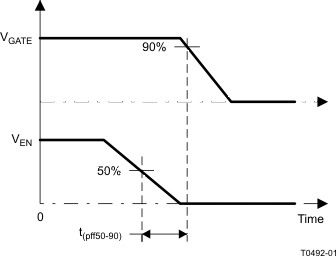 Figure 1. tpff50–90 Timing Definition
Figure 1. tpff50–90 Timing Definition
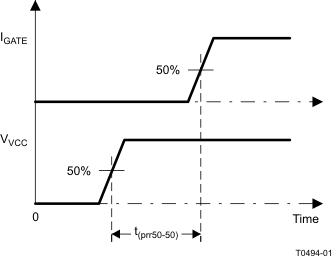 Figure 3. tprr50–50 Timing Definition
Figure 3. tprr50–50 Timing Definition
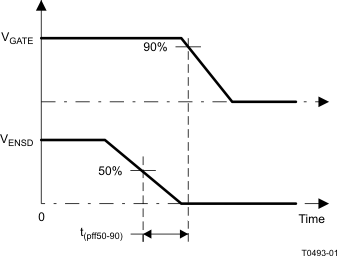 Figure 2. tpff50–90 Timing Definition
Figure 2. tpff50–90 Timing Definition
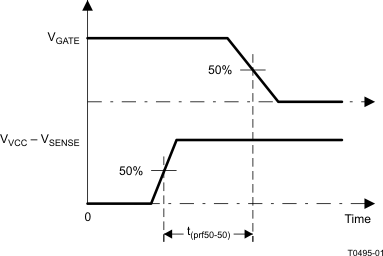 Figure 4. tprf50–50 Timing Definition
Figure 4. tprf50–50 Timing Definition
6.7 Typical Characteristics
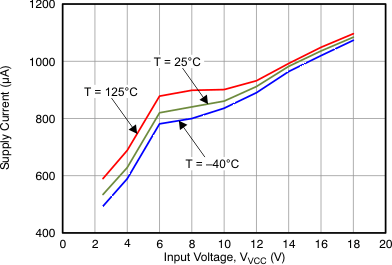
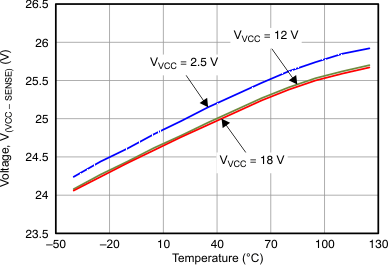
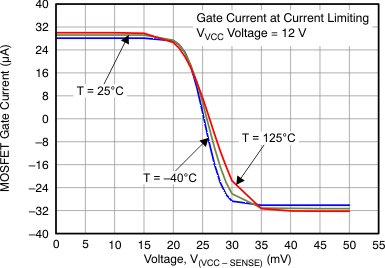
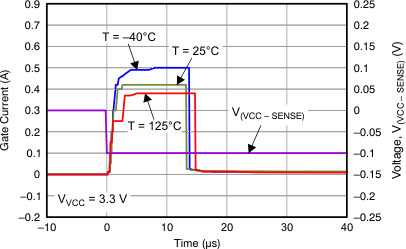
VVCC = VGATE = 3.3 V
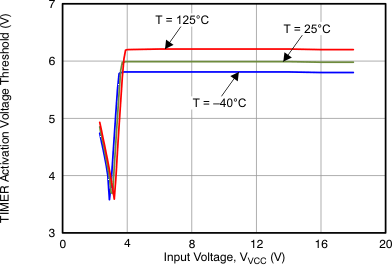
vs Input Voltage at Various Temperatures
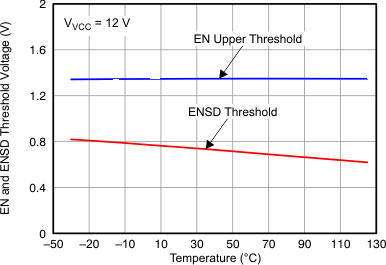
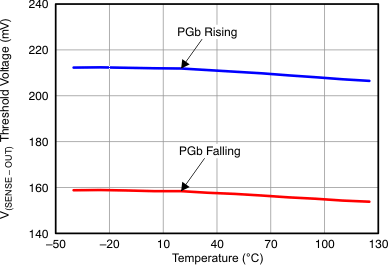
PGb Rising and Falling
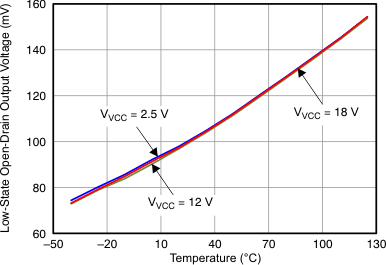
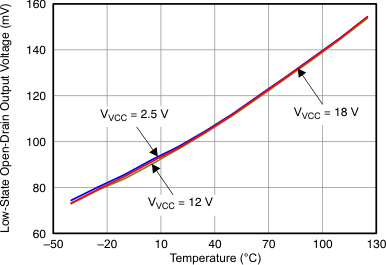
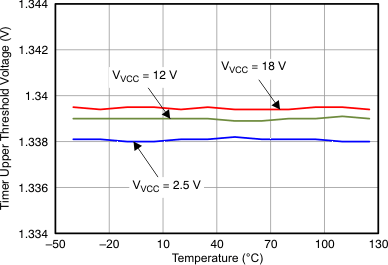
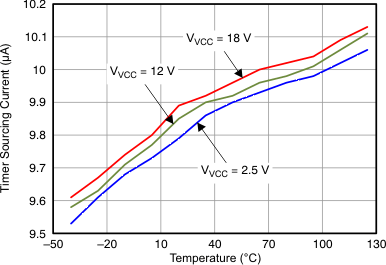
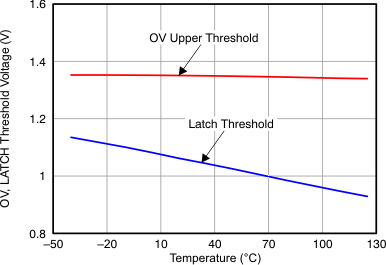
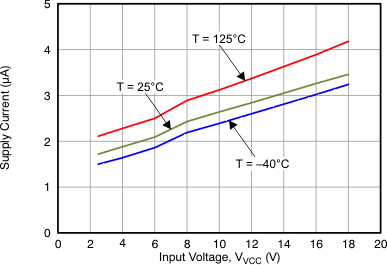
(EN = 0 V)
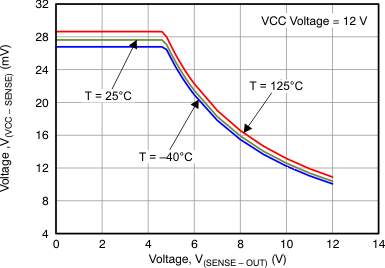
vs VDS of Pass MOSFET
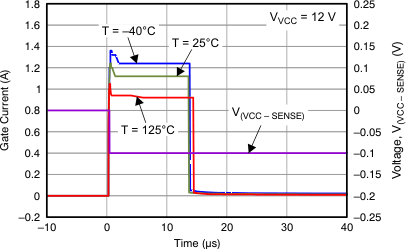
VVCC = VGATE = 12 V
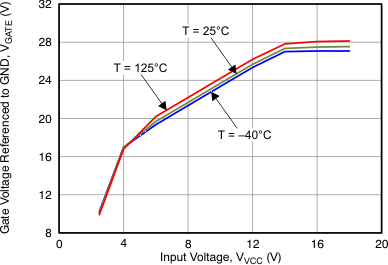
vs Input Voltage
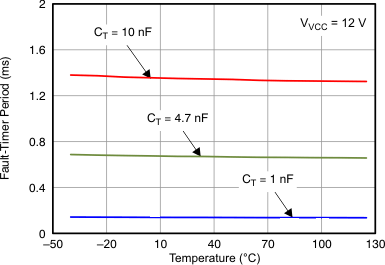
TIMER Capacitors
